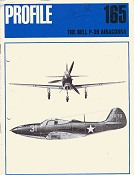 Jay Frank Dial, “the
Bell P-39 Airacobra”, Aircraft in Profile no. 165, ©1965 Profile
Publications ltd., Coburg House, Sheet Street, Windsor, Berkshire, England.
No ISBN.
Jay Frank Dial, “the
Bell P-39 Airacobra”, Aircraft in Profile no. 165, ©1965 Profile
Publications ltd., Coburg House, Sheet Street, Windsor, Berkshire, England.
No ISBN.The P-39 Airacobra was one of the fighters that the USA had to its disposal at the outbreak of the second World War. Not much loved by most of its US pilots, it was later used with great effect by the Russian Army Air Force. This rather innovative plane (motor in the middle, steerable nose wheel and originally turbo-supercharged) never got quite the credit it deserved, but nevertheless has seen the subject of some very different reference books.
But as a modeller you might ask yourself “which book is best for me, which books offer the best value for money?”
And that is again a question easier asked than answered. What exactly are you after? Detail drawings or detail photographs for that bit of extra for your model, color side views for a different version than the standard box model, scale plans to scratch-build a kit yourself, or historical background information for your kit or diorama?
In this overview I will present the Airacobra references from my own library, and mention their strong and weak points, from my point of view (keeping the modeller in mind). In chronological sequences of their first publishing date they are:
 Jay Frank Dial, “the
Bell P-39 Airacobra”, Aircraft in Profile no. 165, ©1965 Profile
Publications ltd., Coburg House, Sheet Street, Windsor, Berkshire, England.
No ISBN.
Jay Frank Dial, “the
Bell P-39 Airacobra”, Aircraft in Profile no. 165, ©1965 Profile
Publications ltd., Coburg House, Sheet Street, Windsor, Berkshire, England.
No ISBN.
Reprinted at least once in 1971 (blue cover compared to the original red) and once in the 80ies (another blue cover).
Pros: it has everything, if only in small amounts. This is mainly because of its size: the standard 12 pages of the older issues of “Aircraft in Profile”. There are general reference guides offering you as least as much text on the Airacobra and sometimes with comparable artwork/drawings as well.
Cons: it is long out of print, so hard to get. Costs of second hand profiles are sometimes as high as later, bigger and better books.
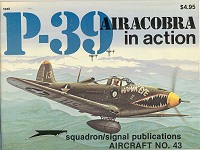 Ernest McDowell,
“P-39 Airacobra in action”, series Aircraft in Action no. 43, ©1980
Squadron/Signal Publications, inc., Carrollton, Texas 75006, USA ISBN
0-89747-102-4.
Ernest McDowell,
“P-39 Airacobra in action”, series Aircraft in Action no. 43, ©1980
Squadron/Signal Publications, inc., Carrollton, Texas 75006, USA ISBN
0-89747-102-4.
Pros: the best all-round Airacobra reference when it appeared. Four times the size of the Aircraft in Profile and very affordable (less than $9). Good color art. It also quite adequately covers the P-63 Kingcobra. Though one of the older “In Actions”, it is still in print, unaltered.
Cons: the amount of historical information is considerable less than in some later references.
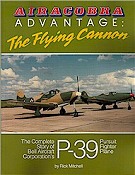 Rick Mitchell,
“Airacobra Advantage: The Flying Cannon. The Complete Story of Bell
Aircraft Corporation’s P-39 Pursuit Fighter Plane”, ©1992, Pictorial
Histories Publishing Company, Missoula, Montana 59801, USA. ISBN
0-929521-62-5
Rick Mitchell,
“Airacobra Advantage: The Flying Cannon. The Complete Story of Bell
Aircraft Corporation’s P-39 Pursuit Fighter Plane”, ©1992, Pictorial
Histories Publishing Company, Missoula, Montana 59801, USA. ISBN
0-929521-62-5
Reprinted at least once in 1995.
Pros: very good on history, from several different intakes. It has a ‘classical’ history, but also a chronological comparison section and nine personal histories (amongst them a female ferry pilot and ‘Chuck’ Yeager). Good on surviving Airacobra warbirds up to 1992. A very good bibliography section finishes the book. Good black-and-white photography.
Cons: apart from the cover it lacks both color photographs and color art, it has no side views or scale plans. More for the historian than for the modeller.
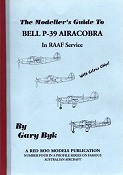 Gary Byk, “The
Modeller’s Guide To The Bell P-39 Airacobra In RAAF Service”, Profile
series on famous Australian Aircraft: no.4, ©1997 Red Roo Models,
Melbourne, Australia.
Gary Byk, “The
Modeller’s Guide To The Bell P-39 Airacobra In RAAF Service”, Profile
series on famous Australian Aircraft: no.4, ©1997 Red Roo Models,
Melbourne, Australia.
No ISBN, but each book is individually bound, numbered and signed(?) by the author.
Mine is no. 385, but I signed it myself.
Pros: absolutely the book to buy if you want to build yourself an Australian Airacobra. Has a modeller’s section discussing the Heller, Revell and Airfix 1:72 kits and the Monogram 1:48. Detailed history of every single Airacobra the Aussies flew. Color photographs of the actual Australian planes.
Cons: you have to imagine yourself the actual colors of the side views. This is helped by the paint chips in appendix III however.
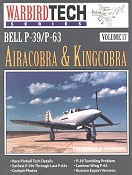 Frederick A. Johnsen,
“Bell P-39/P-63 Airacobra & Kingcobra”, WarbirdTech series vol.17,
Frederick A. Johnsen,
“Bell P-39/P-63 Airacobra & Kingcobra”, WarbirdTech series vol.17,
©1998, Specialty Press Publishers, North Branch, Minnesota 55056, USA.
ISBN 1-58007-010-8.
Pros: Twice the pages of the ‘In Action’, giving you more about a lot of subjects.
Cons: severely lacking in both variant drawings and color art of any kind. More for the technically interested historian than for the modeller.
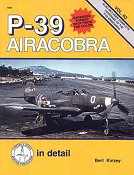 Bert Kinzey, “P-39
Airacobra in detail”, series detail and scale, vol.63, ©1999
Bert Kinzey, “P-39
Airacobra in detail”, series detail and scale, vol.63, ©1999
Squadron/Signal Publications, inc., Carrollton, Texas 75006, USA. ISBN 1-888974-16-4
Pros: much detail photographs, both in color and in black-and-white. Scale plans and variant difference drawings. Modelling section about three scales; 1/144, 1/72 and 1/48.
Cons: being published in 1999, the modelling section was already a bit outdated upon publication.
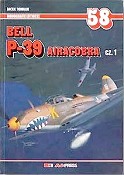 Jacek Tomalik, “Bell
P-39 Airacobra Cz.1”, series Monografie Lotnicze no. 58, ©1999 AJ-Press,
Gdansk, Poland, ISBN: 83-7237-032-X
Jacek Tomalik, “Bell
P-39 Airacobra Cz.1”, series Monografie Lotnicze no. 58, ©1999 AJ-Press,
Gdansk, Poland, ISBN: 83-7237-032-X
Pros: excellent color art, scale plans and drawings (even four color side views of Australian Airacobras), very good black-and-white photography. And this is only part one of a series of two about the Airacobra.
Cons: it is not cheap and it is entirely in the Polish language (Good news for those who read Czech: there is a Czech translation), not even small English captions. One might hope for an English translation of these titles (volume one and two)
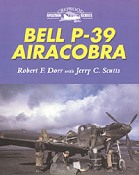 Robert F. Dorr and
Jerry C. Scutts, “Bell P-39 Airacobra”, Crowood Aviation series
(unnumbered), ©2000, The Crowood Press Ltd., Ramsbury, Marlborough,
Wiltshire SN8 2HR, England. ISBN 1-86126-348-1
Robert F. Dorr and
Jerry C. Scutts, “Bell P-39 Airacobra”, Crowood Aviation series
(unnumbered), ©2000, The Crowood Press Ltd., Ramsbury, Marlborough,
Wiltshire SN8 2HR, England. ISBN 1-86126-348-1
Pros: extensive year-by-year history, together with information about surviving Airacobra warbirds up to 2000. Also attention for the P-63 Kingcobra. Excellent photography.
Cons: expensive, being a hardcover. No color art or photography, apart from the cover picture. No scale plans, no side views. Not so much written with the modeller in mind, but great for the historian who likes photographs to go with the text.
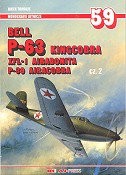 Jacek Tomalik, “Bell
P-63 Kingcobra, XFL-1 Airabonita, P-39 Airacobra Cz.2”, series Monografie
Lotnicze no. 59, ©2001 AJ-Press, Gdansk, Poland, ISBN: 83-7237-034-6
Jacek Tomalik, “Bell
P-63 Kingcobra, XFL-1 Airabonita, P-39 Airacobra Cz.2”, series Monografie
Lotnicze no. 59, ©2001 AJ-Press, Gdansk, Poland, ISBN: 83-7237-034-6
Pros: the part two of a series within a series. Again excellent color art, scale plans and drawings, very good black-and-white photography, now together with color photography as well. All information you might have thought left out of volume one is here in volume two.
The Airabonita, the various Kingcobras, the V-tail, the swept wing, racer N-9009, everything.
Cons: it is not the cheapest reference around –specially not together with volume one- and it is entirely in the Polish language (there is not even a Czech translation as far as I know), but if you can read Polish there is no better choice than these two volumes, together 172 pages of first class information.
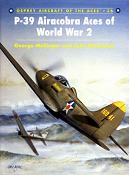 George Mellinger and
John Stanaway, “P-39 Airacobra Aces of World War 2”, series Osprey Aircraft
of the Aces no.36, ©2001, Osprey Publishing, Oxford OX2 9LP, England.
George Mellinger and
John Stanaway, “P-39 Airacobra Aces of World War 2”, series Osprey Aircraft
of the Aces no.36, ©2001, Osprey Publishing, Oxford OX2 9LP, England.
ISBN 1-84176-204-0
Pros: much color side views, accompanied with photographs of the actual plane and information about the actual pilot flying that plane (the one from the side view), together with close-up detail of their nose art or score boards. You can build great diorama’s with this book in hand.
Cons: it is by nature of the subject more about the pilots than about the plane itself. You’ll get more close-ups about Russian Airacobra aces than from Russian Airacobras
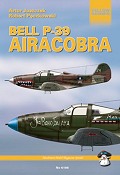 Artur Juszczak and
Robert Pęcvkowski, “Bell P-39 Airacobra”, series yellow no.6, ©2003,
Artur Juszczak and
Robert Pęcvkowski, “Bell P-39 Airacobra”, series yellow no.6, ©2003,
Stratus, 27-600 Sandomierz, Poland/Mushroom Model Publications, Redbourn AL3 7PE, England. ISBN 83-916327-9-2
Pros: great on detail (even though one P-63 nose gear crept in on page 98), very good on variant differences, color art and scale plans. Good value for money.
Cons: because the book is already packed with detail, the amount of and room for historical information is considerably less than in other recent references (Mushroom books keep for that for their red and orange series).
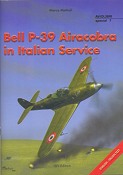 Marco Mattioli, “Bell
P-39 Airacobra in Italian Service”, series Aviolibri Special 7, ©2003, IBN
Editore, 00161 Rome, Italia. SBN 88-86815-85-9
Marco Mattioli, “Bell
P-39 Airacobra in Italian Service”, series Aviolibri Special 7, ©2003, IBN
Editore, 00161 Rome, Italia. SBN 88-86815-85-9
Pros: fully bi-lingual (Italian/English), focusing on a part other books only briefly mention if at all: the Italian Airacobras. Extensive and very good 10-page modeller’s section (all color photographs are in this section), focusing on a upgrade of the already beautiful Czech 1/48 Eduard kit. Good tips to improve an already good kit. Good color art for alternative versions.
Cons: no scale plans, no variant drawings.
People wishing more information on the “Pinball” version of the Kingcobra should look for:
Ivan Hickman, “Operation Pinball, the USAAF’s secret aerial gunnery program in WWII”, ©1990 Motorbooks International Publishers, Osceola, Wisconsin 54020, USA
ISBN 0-87938-472-7
Not every fighter pilot was an ace or a hero. Some just did not have it. A very personal and honest account of what it really was, flying a P-39 Airacobra, is given in:
Edwards Park, “Nanette, her pilot’s love story”, ©1977, 1989 Smithsonian Press, Washington/London ISBN 0-87474-737-6
A very thorough description of the Russian use of the Airacobra is given in:
Dmitriy Loza (translated by James F. Gerbhardt), “Attack of the Airacobras, Soviet Aces, American P-39s & the War against Germany”, ©2002 University Press of Kansas, Lawrence, Kansas 66049, USA (www.kansaspress.ku.edu) ISBN 0-7006-1140-1
How the Airacobras and Kingcobras got in Russia is described –amongst others- in:
Everett A. Long and Ivan Y. Neganblya, “Cobras over the Tundra”, ©1992 Artika, Reno, Nevada 89523, USA ISBN 0-9634578-1-0
Those who want to build a British Airacobra couldn’t do without either the separately published part 12 or the bound volume of
James Goulding and Robert Jones, “Camouflage & Markings, RAF Fighter Command Northern Europe, 1936 to 1945”, ©1970-1971 Ducimus Books Ltd., London SW13, England
No ISBN
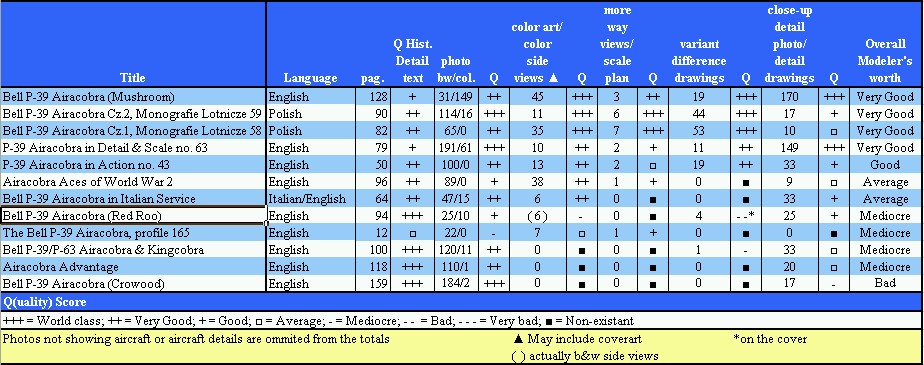
All books by courtesy of my own wallet. Much obliged to the Luchtvaarthobbyshop at Aalsmeerderbrug, the Netherlands (near Schiphol) for stocking most of them. Others were bought at Amazon.com, or straight from Squadron/Signal.